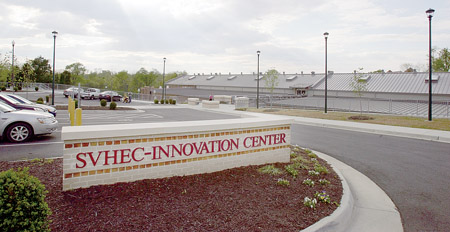It used to be called the Bag Factory. Today, the name is ditched for something entirely more glamorous and appropriate: the Innovation Center – an expansion of the Southern Virginia Higher Education Center, two doors away.
A $10 million complex, the Innovation Center is a model of industrial chic – a new jewel in South Boston’s Warehouse District that includes the Higher Ed Center itself and, in between, The Prizery arts center.
But it’s more than a pretty face and an old building saved.
It’s a place where people can do and learn things – as Halifax Education Foundation Development Director Tommy Nelson explains, it’s the space for the more non-traditional pursuit; the main building now focuses on the more traditional student.
Activities in the Innovation Center are geared to jobs: skills re-training for individuals or specialty training at the request of a business.
Area employers are taking notice – it’s now one of the first stops for economic development prospects – but Nelson hopes the weekend’s open house will raise its profile even higher: “Somebody’s going to see something on Sunday” that will spark conversations or phone calls..
“We’re ready to show it off,” he boasts.
Inside:
- Its centerpiece is the Business of Art & Design program, where students (some of them still in high school) can earn either a certificate or an associate degree in either digital art and design or product design and development. That degree can then segue into a four-year college if the student chooses. (It’s under this umbrella that one finds the high-profile programs for wood design and production.)
- The R&D Center for Advanced Manufacturing and Energy Efficiency – one of six energy centers around the state established the Tobacco Commission – can be a place where firms come to solve product design dilemmas, assist in the creation of new products and components and lower manufacturing costs through technological efficiencies.
- Companies can seek out Workforce Services for their employees – whether for a three-year program such as what Presto Products is doing, or whether for a one-day, on-site, in-person class; packaged or customized.
What’s the coolest aspect of what the Higher Ed folks consider a cool building?
Higher Ed’s Communications Manager Hope Harris-Gayles says her tours “lose the most time” looking at the advanced manufacturing equipment. People can’t believe machines of that caliber are in South Boston, she says.
Of the whole package “everyone’s just awestruck,” she says.
Tommy Nelson points to the fact that the building is already paid for, and without state money.
Coordinator of the Business of Art & Design program Ben Capozzi raves about state-of-the-art equipment: “This facility is outfitted so as to make four-year institutions jealous,” he crows.
Capozzi also likes what he calls the “concentration” of putting seemingly unrelated programs under one roof.
“The studio environment promotes open dialogue, conspicuous competition, camaraderie and the chance meetings that can drive innovation,” he says. “I’m reminded of how Steve Jobs designed the studios at Pixar with the restroom facilities placed at the heart of the space, so that everyone from the CEO to the custodian was likely to meet at the same place throughout the day. That facilitates the chance encounters and exchanges that can drive innovative thinking. We’re facilitating [that] here.”
Also eye-catching is the 80-seat tiered classroom, decked out with the capability to host live or streaming conferences.
Among the other gee-whiz aspects of the rehabilitation – in addition to the design by Pape, Cole and Associates of Norfolk – may not be obvious to the casual observer, and that’s its LEED designation.
LEED – the acronym for Leadership in Energy and Environmental Design – is a rating system for designing, constructing and operating “green” buildings.
Workers went to great lengths to recycle packing cardboard, plastics and even ripped-out concrete.
New windows and doorframes at the Innovation Center were created from old beams taken from the same building.
The Center’s Chief Financial Officer Patty Nelson (no relation) says the Tobacco Commission was keen on LEED (especially by this being an energy center). And despite the up-front expense, Nelson is “shocked” by the lower electrical and water bills – roughly 50 percent less than the main building.
(She hasn’t analyzed the statistics carefully yet, and she concedes that so far there are fewer people in the building, but there are also big, energy-siphoning machines – and still the bills are better.)
Tommy Nelson points to the four tanks on the roof catching rainwater. That so-called gray water is then used in the Innovation Center’s toilets and for irrigating its landscaping.
Pretty neat for an abandoned 100-year-old tobacco warehouse that was once, in Tommy Nelson’s words, “awful.”
Paid for with $6 million in Tobacco Commission funds plus $4 million in historical tax credits, local contractors McDannald Construction and J.E. Burton Construction worked their magic on the renovation.
So the total remodeling job – kind of an understatement given the decrepitude of the building – was about $10 million, according to Patty Nelson.
To outfit the place – with about $1.3 million in equipment – about $400,000 in advanced manufacturing equipment (paid for by the Halifax Education Foundation) was transferred over from the main building; a Community Development Block Grant contributed $700,000; one USDA grant chipped in $50,000; another USDA Rural Development grant chipped in $150,000.
The first classes were held there last fall.
The Higher Ed Center this year is serving 4,500 individual students from 16 counties – an astounding reach, to Tommy Nelson. While it is not a community college itself, it is larger than 60 percent of Virginia community colleges.
Tommy Nelson chuckles, remembering that when the forerunner to the Higher Ed Center moved to an old Lowe’s store across from the high school, surely everyone thought that was ample space. When it moved to its main 70,00-square-foot building, that seemed cavernous. Now, the 46,000-square-foot addition gives the main building breathing room, “But I’m pretty sure we’ll need new space here” eventually, he predicts.
Open house is 2-5 p.m. Sunday; visitors who complete the tour will be placed in a drawing for an Apple iPad 3, a Kindle Touch, gas cards and gift cards to local restaurants and businesses. Young people and children are welcome.

